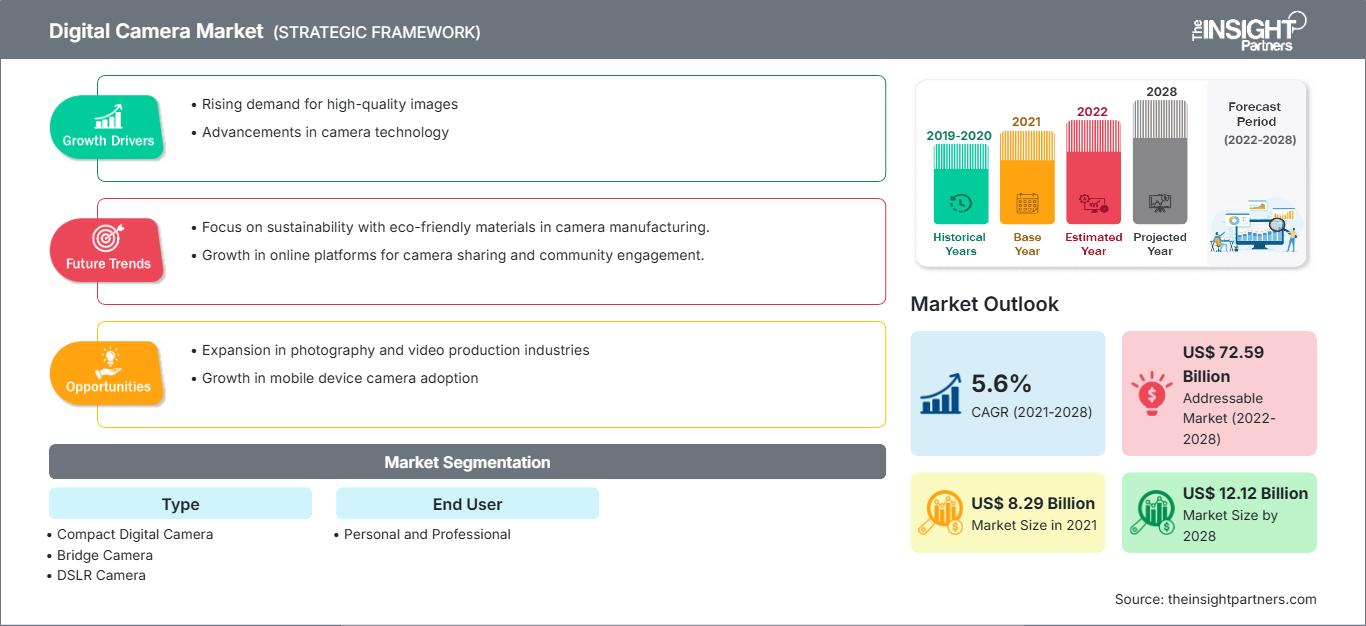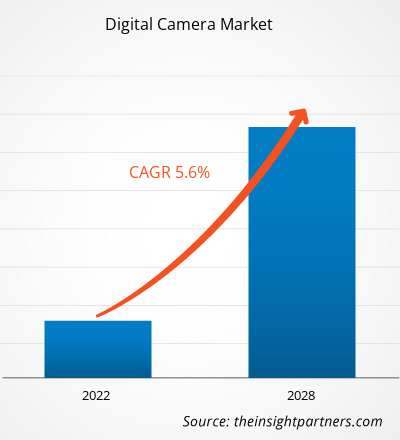Si prevede che il mercato delle fotocamere digitali crescerà da 8.290,25 milioni di dollari nel 2021 a 12.119,44 milioni di dollari entro il 2028; si stima una crescita a un CAGR del 5,6% nel periodo 2021-2028.
L'uso delle fotocamere digitali non si è limitato alla fotografia personale e professionale, ma si è esteso ai settori dell'intrattenimento, dei media e dello sport. L'industria cinematografica è una delle categorie più grandi e redditizie dell'industria dell'intrattenimento globale. Ad esempio, l'industria cinematografica cinese è una delle più grandi al mondo, con un fatturato di circa 6,6 miliardi di dollari nel 2016. Si prevede che queste promettenti prospettive per l'industria cinematografica e dell'intrattenimento stimoleranno la domanda di fotocamere digitali per ottenere scatti e video perfetti. I rapidi cambiamenti tecnologici, il comportamento dei consumatori e i modelli di business hanno cambiato il modo in cui i consumatori desiderano vivere e pagare l'intrattenimento e i media. I leader di questo settore si stanno concentrando sulla creazione di aziende e marchi incentrati sui tifosi per produrre contenuti eccezionali. Di conseguenza, investono in modo significativo in tecnologie e attrezzature come la computer grafica (CGI) e gli effetti visivi (VFX), nonché in telecamere avanzate. Inoltre, l'uso di telecamere digitali è indispensabile nei media sportivi. L'installazione di telecamere digitali ad alta velocità negli stadi offre agli spettatori la possibilità di vedere replay in slow motion in situazioni di gioco critiche e contribuisce a ottenere immagini precise durante la visione. Allo stesso modo, l'uso di fotocamere digitali ad alta risoluzione nella fotografia naturalistica, paesaggistica, architettonica e in studio aiuta a ottenere immagini e video nitidi e definiti. La crescente attenzione verso la fotografia d'azione ha successivamente promosso la domanda di fotocamere digitali compatte, come GoPro. Inoltre, le piattaforme di social media, come Instagram, hanno ampliato notevolmente le possibilità della fotografia, il che, a sua volta, dovrebbe favorire la crescita del mercato delle fotocamere digitali.
Personalizza questo rapporto in base alle tue esigenze
Potrai personalizzare gratuitamente qualsiasi rapporto, comprese parti di questo rapporto, o analisi a livello di paese, pacchetto dati Excel, oltre a usufruire di grandi offerte e sconti per start-up e università
Mercato delle fotocamere digitali: Approfondimenti strategici

-
Ottieni le principali tendenze chiave del mercato di questo rapporto.Questo campione GRATUITO includerà l'analisi dei dati, che vanno dalle tendenze di mercato alle stime e alle previsioni.
La pandemia di coronavirus ha colpito economie e settori in diversi paesi a causa di lockdown, divieti di viaggio e chiusure aziendali. Il settore dell'elettronica di consumo è uno dei principali settori che ha subito gravi interruzioni, come interruzioni della catena di approvvigionamento, chiusure di impianti di produzione, ecc., a causa di questa pandemia. La chiusura di vari impianti di produzione e fabbriche in regioni chiave come Nord America, Europa, Asia-Pacifico, Sud America, Medio Oriente e Africa ha avuto un impatto sulla catena di approvvigionamento globale e ha avuto un impatto negativo sulla produzione, sui tempi di consegna e sulle vendite di vari beni. Inoltre, diverse aziende hanno già annunciato possibili ritardi nelle consegne dei prodotti e un crollo delle vendite future dei loro prodotti. Oltre a ciò, i divieti di viaggio globali imposti da paesi in Europa, Asia e Nord America stanno influenzando le opportunità di collaborazioni e partnership commerciali. Si prevede che tutti questi fattori influenzeranno negativamente il settore dell'elettronica di consumo e quindi fungeranno da fattore frenante per la crescita di vari mercati correlati a questo settore nei prossimi mesi. Il mercato delle fotocamere digitali è influenzato dalla pandemia a causa della carenza di produzione e delle limitate infrastrutture di trasporto.
Approfondimenti sul mercato delle fotocamere digitali: le innovazioni tecnologiche associate alle fotocamere digitali alimentano la crescita del mercato delle fotocamere digitali
Il contesto del mercato delle fotocamere digitali è strettamente legato a tendenze radicali emergenti, supportate da sviluppi tecnologici innovativi e robusti progressi, come l'HD e il touchscreen. Da tempo, il mercato ha osservato una maggiore domanda di fotocamere reflex digitali e reflex digitali (SLR) a causa della crescente propensione dei consumatori verso la fotografia avanzata. Tuttavia, il progresso tecnologico ha portato alla creazione di fotocamere ad alta risoluzione, che offrono da 12 a 20 megapixel. La continua evoluzione nel campo delle fotocamere digitali ha portato alla progettazione di fotocamere avanzate con una risoluzione migliore, una messa a fuoco più rapida e il supporto a diverse periferiche. Inoltre, è stato osservato un aumento della tendenza a integrare un modem Wi-Fi o 4G nelle fotocamere digitali, per fornire un vantaggio competitivo rispetto agli smartphone. Inoltre, si prevede che tali fotocamere faranno parte di diversi dispositivi interconnessi, come l'IoT (Internet delle cose), che potrebbero facilitare una comunicazione efficace con altri dispositivi interconnessi come smartphone e assistenti vocali nel prossimo futuro.
Approfondimenti di mercato basati sulla tipologia
In base alla tipologia, il mercato delle fotocamere digitali è suddiviso in fotocamere digitali compatte, fotocamere bridge, fotocamere DSLR, fotocamere mirrorless, fotocamere digitali a telemetro e fotocamere a scansione lineare. Nel 2020, il segmento delle fotocamere DSLR ha rappresentato la quota maggiore del mercato.
Approfondimenti regionali sul mercato delle fotocamere digitali
Le tendenze regionali e i fattori che influenzano il mercato delle fotocamere digitali durante il periodo di previsione sono stati ampiamente spiegati dagli analisti di The Insight Partners. Questa sezione analizza anche i segmenti e la geografia del mercato delle fotocamere digitali in Nord America, Europa, Asia-Pacifico, Medio Oriente e Africa, America meridionale e centrale.
Ambito del rapporto sul mercato delle fotocamere digitali
| Attributo del rapporto | Dettagli |
|---|---|
| Dimensioni del mercato in 2021 | US$ 8.29 Billion |
| Dimensioni del mercato per 2028 | US$ 12.12 Billion |
| CAGR globale (2021 - 2028) | 5.6% |
| Dati storici | 2019-2020 |
| Periodo di previsione | 2022-2028 |
| Segmenti coperti |
By Tipo
|
| Regioni e paesi coperti |
Nord America
|
| Leader di mercato e profili aziendali chiave |
|
Densità degli operatori del mercato delle fotocamere digitali: comprendere il suo impatto sulle dinamiche aziendali
Il mercato delle fotocamere digitali è in rapida crescita, trainato dalla crescente domanda degli utenti finali, dovuta a fattori quali l'evoluzione delle preferenze dei consumatori, i progressi tecnologici e una maggiore consapevolezza dei vantaggi del prodotto. Con l'aumento della domanda, le aziende stanno ampliando la propria offerta, innovando per soddisfare le esigenze dei consumatori e sfruttando le tendenze emergenti, alimentando ulteriormente la crescita del mercato.

- Ottieni il Mercato delle fotocamere digitali Panoramica dei principali attori chiave
In base all'applicazione, il mercato delle fotocamere digitali è segmentato in personale e professionale. Nel 2020, il segmento professionale ha rappresentato una quota di mercato maggiore.
Gli operatori che operano nel mercato digitale adottano strategie come fusioni, acquisizioni e iniziative di mercato per mantenere le proprie posizioni sul mercato. Di seguito sono elencati alcuni sviluppi dei principali operatori:
- FUJIFILM Holdings Corporation ha annunciato il lancio di FUJIFILM GFX100S a fine febbraio 2021. La fotocamera è l'ultima aggiunta alla serie GFX di fotocamere digitali mirrorless.
- Nikon Corporation ha lanciato la fotocamera mirrorless full-frame Z 7II. La Z 7II è una fotocamera mirrorless full-frame ad alta risoluzione. Attraverso il lancio di tali prodotti, l'azienda contribuisce allo sviluppo della cultura dell'imaging.
Il mercato delle fotocamere digitali è stato segmentato come segue:
Per tipo
- Fotocamera digitale compatta
- Fotocamera bridge
- Fotocamera DSLR
- Fotocamera mirrorless
- Fotocamera digitale con telemetro
- Fotocamera a scansione lineare
Per utente finale
- Personale
- Professionista
Per area geografica
-
Nord America
- Stati Uniti
- Canada
- Messico
-
Europa
- Francia
- Germania
- Italia
- Regno Unito
- Russia
- Resto del Europa
-
Asia Pacifico (APAC)
- Cina
- India
- Corea del Sud
- Giappone
- Australia
- Resto dell'APAC
-
Medio Oriente e Africa (MEA)
- Sudafrica
- Arabia Saudita
- Emirati Arabi Uniti
- Resto del MEA
-
Sud America (SAM)
- Brasile
- Argentina
- Resto del SAM
Profili aziendali
- Canon Inc.
- Eastman Kodak Company
- Fujifilm Holdings Corporation
- Leica Camera Ag
- Nikon Corporation
- Om Digital Solutions Corporation
- Panasonic Corporation
- Hasselblad
- Ricoh Imaging Company, Ltd,
- Sony Corporation
- Analisi storica (2 anni), anno base, previsione (7 anni) con CAGR
- Analisi PEST e SWOT
- Valore/volume delle dimensioni del mercato - Globale, Regionale, Nazionale
- Industria e panorama competitivo
- Set di dati Excel
Report recenti
Rapporti correlati
Testimonianze
Motivo dell'acquisto
- Processo decisionale informato
- Comprensione delle dinamiche di mercato
- Analisi competitiva
- Analisi dei clienti
- Previsioni di mercato
- Mitigazione del rischio
- Pianificazione strategica
- Giustificazione degli investimenti
- Identificazione dei mercati emergenti
- Miglioramento delle strategie di marketing
- Aumento dell'efficienza operativa
- Allineamento alle tendenze normative






















 Ottieni un campione gratuito per - Mercato delle fotocamere digitali
Ottieni un campione gratuito per - Mercato delle fotocamere digitali